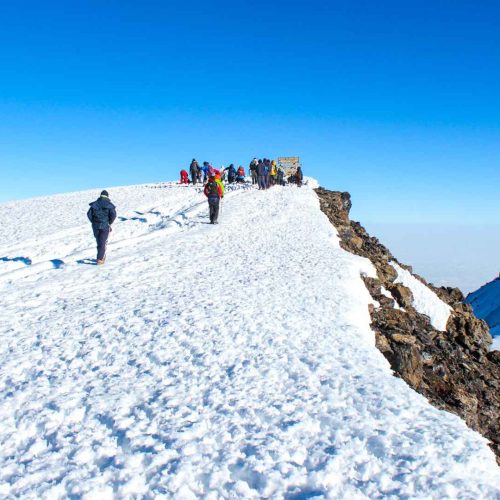Weather on Mount Kilimanjaro

Kilimanjaro Weather
What's Kilimanjaro Weather Like?
Expect varied weather conditions on your Kilimanjaro climb.
“Mountains make their own weather”
Standing at a staggering height of 19,341 ft. above sea level, Kilimanjaro is certainly big enough to create its own weather systems. Besides the altitude, the biggest factor affecting the Weather In Kilimanjaro is the interaction of trade winds.
Due to its close proximity to the equator, the trade winds (monsoons) that move across the ocean, drawing moisture upwards are likely to get interrupted by the mountain. As a result, the wind pushes up towards the summit, cooling down as it goes, bringing rain and snow. Therefore even if the temperature varies very little there are big changes in rainfall.
Generally, the month of April and May are the wettest period of Kilimanjaro. This is the result of dominant winds coming in from the South-east at this time of year. The winds pick up a great deal of moisture while traveling over the Indian Ocean. Later when it gets forced up the mountain and cools, it condenses and turns into clouds and precipitation.
If you’re Climbing Mount Kilimanjaro during this period then we advise you to avoid southern slopes. Because this side of the mountain gets the most rain during these months. We’ll suggest you to take the Rongai Route because it takes a trail up the northern side of Kilimanjaro and generally gets less rain.
Kilimanjaro experiences its driest months from June through to October. During this time anti-trade winds blow in strongly from the northeast. These winds carry almost no moisture and force the South-east winds downwards. Thus keeping the mountain relatively free of precipitation and clouds, especially higher up. We recommend popular routes like the Machame Route or Lemosho Route for this period.
November marks the beginning of the Northeast monsoon period bringing frequent to light rains on the north side of Kilimanjaro.
Kilimanjaro Summit Weather Conditions
Prepare for the extreme weather at Kilimanjaro’s summit.
As you already know, the Kilimanjaro Summit Attempt starts at around midnight. You’ll be hiking in the bitter cold, often with snow or ice on the trail. We aim to reach Uhuru Peak by sunrise. As at the top, vast panoramic views of Mawenzi and out over the African plains are waiting for you to explore.
At Uhuru Point, the Kilimanjaro Summit Temperatures can range between 20 and -20 degrees Fahrenheit (-7 to -29 degrees Celsius).
Explore Our Kilimanjaro Tour Packages
- Quality4.67
- Location4.67
- Amenities4.67
- Services5
- Price4.33
6 Days Kilimanjaro's Hiking Machame Route
- Quality4.67
- Location4.67
- Amenities4.67
- Services5
- Price4.33
6 Days Kilimanjaro's Hiking Marangu Route
- Quality4.67
- Location4.67
- Amenities4.67
- Services5
- Price4.33
6 Days Kilimanjaro's Hiking Umbwe Route
- Quality4.67
- Location4.67
- Amenities4.67
- Services5
- Price4.33
6 Days Kilimanjaro's Hiking Rongai Route
- Quality4.67
- Location4.67
- Amenities4.67
- Services5
- Price4.33
7 Days Kilimanjaro's Hiking Umbwe Route
- Quality4.67
- Location4.67
- Amenities4.67
- Services5
- Price4.33
7 Days Kilimanjaro's Hiking Rongai Route
- Quality4.67
- Location4.67
- Amenities4.67
- Services5
- Price4.33
7 Days Kilimanjaro's Hiking Machame Route
- Quality4.67
- Location4.67
- Amenities4.67
- Services5
- Price4.33
7 Days Kilimanjaro's Hiking Lemosho Route
- Quality4.67
- Location4.67
- Amenities4.67
- Services5
- Price4.33
8 Days Kilimanjaro's Hiking Lemosho Route
- Quality4.67
- Location4.67
- Amenities4.67
- Services5
- Price4.33
9 Days Kilimanjaro's Hiking Northern Circuit Route
- Quality4.67
- Location4.67
- Amenities4.67
- Services5
- Price4.33
6 Days Affordable Safari Holidays
- Quality4.67
- Location4.67
- Amenities4.67
- Services5
- Price4.33












